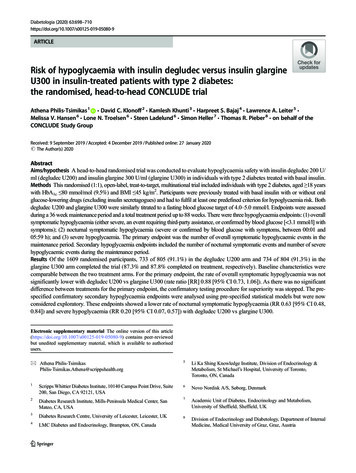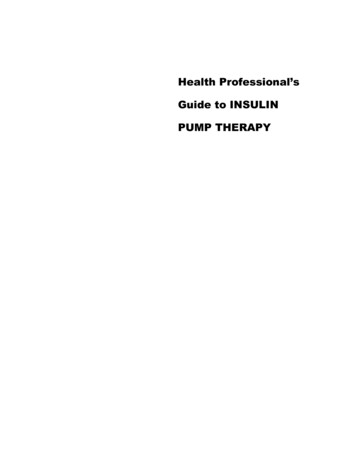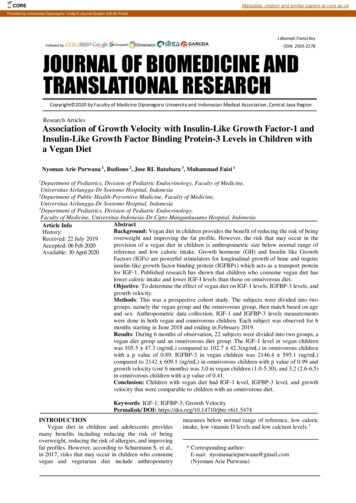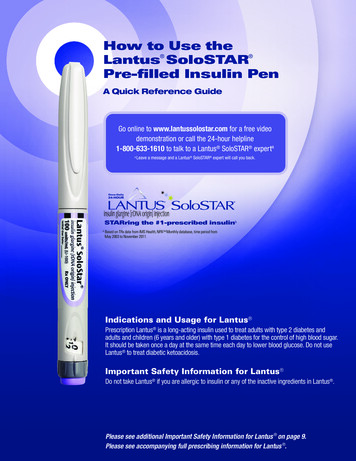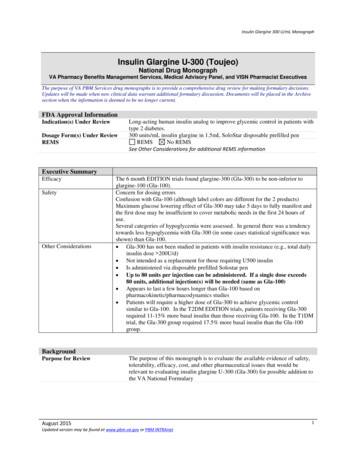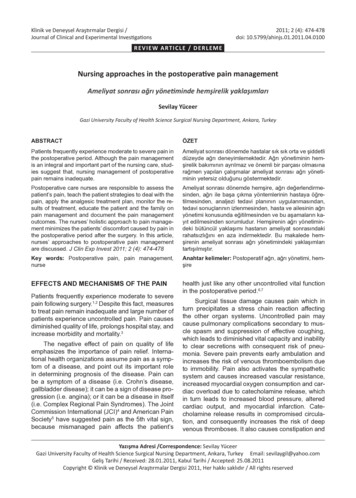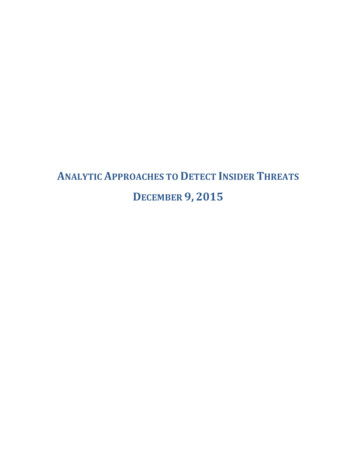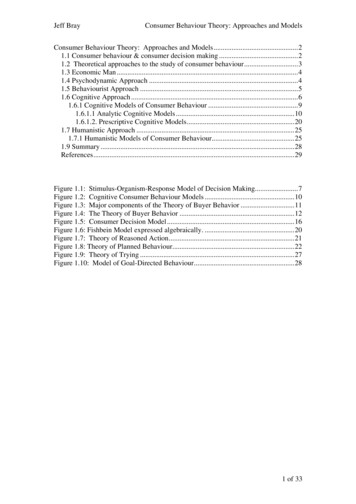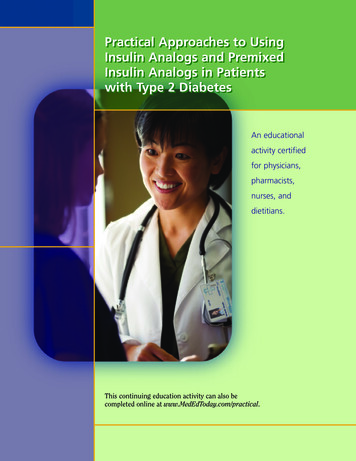
Transcription
Practical Approaches to UsingInsulin Analogs and PremixedInsulin Analogs in Patientswith Type 2 DiabetesAn educationalactivity certifiedfor physicians,pharmacists,nurses, anddietitians.This continuing education activity can also becompleted online at www.MedEdToday.com/practical.
Program GoalAccreditationThe goal of this program is to provide theoretical andpractical knowledge to healthcare providers regarding theuse of insulin analogs and premixed insulin analogs inpatients with type 2 diabetes.In order to receive your CME Certificate or Statement ofCredit, you must read the monograph and complete andreturn the post test and evaluation. Your statement willbe mailed within 6 to 8 weeks upon receipt of yourmaterials. There is no cost to participate.Target AudienceRelease date: October 16, 2006Expiration date: October 16, 2008This activity is intended for physicians, pharmacists,nurses, and dietitians who care for patients with type 2diabetes.Educational Objectives Review the prevalence and progressive nature ofdiabetes and the associated economic implications. Discuss the importance of glycemic control in type 2diabetes and current strategies for achieving it.This activity has been planned and implemented inaccordance with the Essential Areas and Policies ofthe Accreditation Council for Continuing MedicalEducation (ACCME) through the joint sponsorship ofthe American Academy of CME, Inc. and Scherer ClinicalCommunications. The American Academy of CME, Inc. isaccredited by the ACCME to provide continuing medicaleducation (CME) for physicians. Explain how and when to initiate insulin for type 2diabetes, including advantages and potential barriers. Compare different insulin formulations and regimensfor type 2 diabetes, and discuss their appropriatenessfor different patient types. Review recent advances in insulin technology and theuse of diabetes-care teams.Physician CreditThe American Academy of CME, Inc. designates thiseducational activity for a maximum of 1.50 AMA PRACategory 1 Credit(s) . Physicians should only claimcredit commensurate with the extent of theirparticipation in the activity.Editorial Review BoardJohn B. Buse, MD, PhD, FACEChief, Division of General Internal MedicineDirector, Diabetes Care CenterUniversity of North Carolina School of MedicineChapel Hill, North CarolinaBarbara Kocurek, PharmD, BCPS, CDEDiabetes Education CoordinatorBaylor Health Care SystemIrving, TexasCarolyn Robertson, APRN, MSN, BC-ADM, CDEAssociate DirectorNew York Diabetes ProgramNew York, New YorkGretchen A. Youssef, MS, RD, CDEProgram ManagerMedStar Diabetes InstituteWashington, DCPharmacistsThe American Academy of CME, Inc. isaccredited by the Accreditation Council forPharmacy Education (ACPE) as a providerof continuing pharmacy education. Thisprogram provides 1.50 contact hours (0.150 CEUs) ofcontinuing education credit.ACPE Universal Program Number 297-999-06-015-H01.Registered NursesThe American Academy of CME, Inc.(Academy) is accredited as a provider ofcontinuing nursing education by theAmerican Nurses Credentialing Center’sCommission on Accreditation.The Academy designates this educational activity for 1.50contact hours.ANCC Accredited Providers have been approved by TheNational Certification Board for Diabetes Educators(NCBDE) as providers of continuing education.Individuals seeking recertification from the NCBDE canuse continuing education contact hours received throughparticipation in this activity.Practical Approaches to Using Insulin Analogs and Premixed Insulin Analogs in Patients with Type 2 Diabetes
DietitiansDisclaimersThe American Academy of CME, Inc. is aContinuing Professional Education (CPE)Accredited Provider with the Commission onDietetic Registration (CDR) from June 1, 2006 toMay 31, 2009. Registered dietitians (RD) and dietetictechnicians, registered (DTR) will receive 1.50Continuing Professional Education Units (CPEUs) forcompletion of this program. Continuing ProfessionalEducation Provider Accreditation does not constituteendorsement by CDR of a provider, program, ormaterials. Approval of credit for this continuing education (CE)program does not imply endorsement by the AmericanAcademy of CME, Inc. or Scherer ClinicalCommunications of any product or manufactureridentified.Editorial Review Board DisclosuresIt is the policy of the American Academy of CME, Inc. toensure balance, independence, objectivity, and scientificrigor in all sponsored educational activities. Any and allfinancial relationships between the Editorial ReviewBoard and the commercial sponsors of the CME activityand products being discussed are to be disclosed by theEditorial Review Board to the program participants. Thefollowing are the disclosure statements made by themembers of the Editorial Review Board.John B. Buse, MD, PhD, FACE, has disclosed that he isa speaker and consultant to sanofi-aventis. He is also aconsultant and investigator to Amylin Pharmaceuticalsand Eli Lilly and Company. Dr. Buse is an investigator forNovo Nordisk Inc. All of the previously mentionedrelationships are under the control of the University ofNorth Carolina and provide no direct financial benefit toDr. Buse.Barbara Kocurek, PharmD, BCPS, CDE, has disclosedthat she is a member of the advisory board and thespeakers bureau of Novo Nordisk Inc.Carolyn Robertson, APRN, MSN, BC-ADM, CDE, hasdisclosed that she is a consultant for Novo Nordisk Inc.She is also a member of the speakers bureau of AmylinPharmaceuticals and Eli Lilly and Company.Gretchen A. Youssef, MS, RD, CDE, has disclosed thatshe is a member of the advisory board of Eli Lilly andCompany, Novo Nordisk Inc., and sanofi-aventis. Any medications or treatment methods suggested inthis CE activity should not be used by the practitionerwithout evaluation of their patient’s condition(s) andpossible contraindication(s) or danger(s) of use of anyspecific medication. This activity may include discussions of products ordevices that are not currently approved for use by theUS Food and Drug Administration (FDA). The American Academy of CME, Inc., Scherer ClinicalCommunications, the Editorial Review Board, and thecommercial supporter do not endorse the use of anyproduct in a manner that is not approved by the FDA.The Editorial Review Board, sponsor, and publisher ofthis continuing education program have made allreasonable efforts to ensure that information containedherein is accurate in accordance with the latest availablescientific knowledge at the time of accreditation of thiscontinuing education program. Information regardingdrugs (eg, administration, dosages, contraindications,adverse reactions, interactions, special warnings,precautions) and drug delivery systems is subject tochange, however, and the reader is advised to check themanufacturer’s package insert for informationconcerning recommended dosage and potential problemsor cautions prior to dispensing or administering the drugor using the drug delivery systems.TrademarksByetta and Symlin are registered trademarks of AmylinPharmaceuticals, Inc.Apidra and Lantus are registered trademarks of AventisPharmaceuticals Inc.Humalog, Humalog Mix75/25, and Humalog Mix50/50 areregistered trademarks of Eli Lilly and Company.Levemir, NovoLog, and NovoLog Mix 70/30 are registeredtrademarks of Novo Nordisk A/S.Commercial SupporterThis publication is supported by an educational grantfrom Novo Nordisk Inc.Published by Scherer Clinical Communications, 117 West Prospect Street, Hopewell, NJ 08525.Copyright 2006 Scherer Clinical Communications and the American Academy of CME, Inc.Printed in USAOctober 2006
Table of ContentsIntroduction .1Overview .1Contributors to Hyperglycemia.1Why Insulin?.2Type 2 Diabetes Is a Progressive Disease .2Treatment Should Target the Underlying Pathophysiology.2Treatment Goals Are Not Being Met .2Current Stepwise Approach Is Not Working.2Goal Is to Limit Diabetes-Related Complications.3Development of Insulin Analogs and Premixed Insulin Analogs.3When to Initiate Insulin Therapy .4Addressing Patient Concerns.5Which Insulin Formulation? .5Initiating and Titrating Insulin Therapy.6Blood Glucose Monitoring.7Initial Coverage with a Long-Acting Insulin Analog.8Coverage of FPG and PPG with a Premixed Insulin Analog .8Basal-Bolus (Multiple Daily Injection) Therapy .9Carbohydrate Counting and Adjustment of Mealtime Insulin Doses.10Additional Considerations WhenInitiating Insulin Therapy.12Frequency of Blood Glucose Monitoring—Additional Factors.12Dose Adjustments for Special Circumstances .12Using a Diabetes-Care Team Approach .12Improvements in Insulin Delivery Systems.12Summary and Recommendations.13References .13Post-test.15Program Evaluation .17
IntroductionOverviewDiabetes is a debilitating and costly disease that is atepidemic levels in the United States. In 2005, a total of20.8 million Americans, or 7% of the population, wereestimated to have diabetes.1 Ninety to 95% of theseindividuals have type 2 diabetes. Among adults 20 yearsor older, the prevalence of diabetes has increased from8.7% in 2002 to 9.6% in 2005.1,2 In the United States, thetotal (direct and indirect) costs attributable to diabeteswere estimated to be 132 billion in 2002, and diabetesmanagement was estimated to account for more than10% of US healthcare costs.3 These figures likelyunderestimate the true cost of the disease since they donot take into account factors such as pain and suffering,care provided by unpaid caregivers, and services used athigher rates by diabetics than nondiabetics (eg, podiatric,dental, and optometry services). In addition to theincreasing number of Americans with diabetes, it is nowestimated that another 41 million Americans haveprediabetes, based on the revised definition of thiscondition by the American Diabetes Association (ADA).1Patients with type 1 diabetes require insulin from the timeof initial diagnosis, and the majority of patients with type 2diabetes eventually require insulin for optimal glycemiccontrol.4 Due to the progressive nature of type 2 diabetes,it is imperative that healthcare professionals and patientswith diabetes be aware of the benefits and safety of insulin,as well as new advances in insulin formulations anddelivery systems. Insulin is the most effective therapy fordiabetes, and has an excellent safety and tolerability profilewhen dosed properly.5 Insulin analogs and premixedanalogs have overcome many of the shortcomings of theolder human insulin formulations.6–9 The aim of thismonograph is to describe practical approaches to initiatingtherapy with insulin analogs and premixed insulin analogsin patients with type 2 diabetes. This activity will explorethe circumstances under which insulin treatment may beinitiated, along with strategies for selecting the insulin doseand formulation, and adjustment of the regimen.Contributors to HyperglycemiaIn individuals without diabetes, hepatic glucoseproduction and output are limited primarily by basalinsulin secretion, while large peaks in insulin secretionoccur with meals (Figure 1). Diabetes is usuallydiagnosed by a fasting plasma glucose (FPG) 126 mg/dL,where fasting is defined as no caloric intake for at least8 hours.10 The diagnosis may also be made by a randomplasma glucose 200 mg/dL in the presence of symptomsof diabetes (polyuria, polydipsia, and unexplained weightloss) or a 2-hour plasma glucose 200 mg/dL during a75-gram oral glucose tolerance test (OGTT). In all cases,the diagnosis must be confirmed on a separate day unlessunequivocal symptoms of hyperglycemia are present.10The long-term (2–3 months) impact of hyperglycemia onglycemic control is best measured via A1C, which is afunction of both fasting and postprandial glucose (PPG)exposure. Normal A1C is 6% and corresponds to anaverage blood glucose (BG) level of 135 mg/dL. Onaverage, an increase of 1% in A1C corresponds to anincrease in mean plasma glucose of 35 mg/dL.10,11Figure 1. Physiological Serum Insulin SecretionProfile in Nondiabetics75BreakfastLunchDinnerPlasma 50Insulin(µU/mL)25Time (h)Adapted with permission from White JR, Jr., Campbell RK, HirschIB. Novel insulins and strict glycemic control. Analoguesapproximate normal insulin secretory response. Postgrad Med.2003;113:30–36. The McGraw-Hill CompaniesAlthough most patients with diabetes monitor and aimtreatment to achieve fasting glucose targets, PPGexcursions (ie, high BG levels af
diabetes and the associated economic implications. Discuss the importance of glycemic control in type 2 diabetes and current strategies for achieving it. Explain how and when to initiate insulin for type 2 diabetes, including advantages and potential barriers. Compare different insulin formulations and regimens for type 2 diabetes, and discuss their appropriateness for different .
